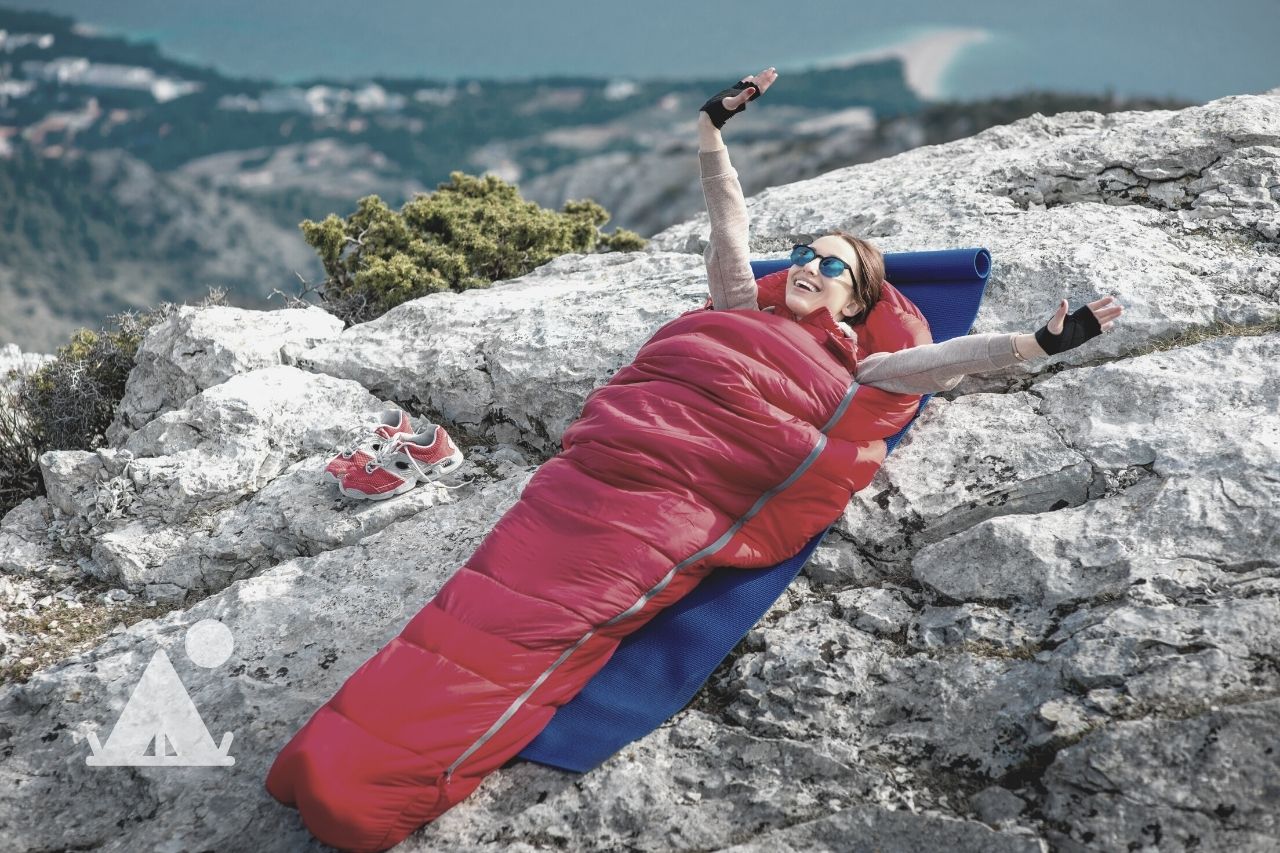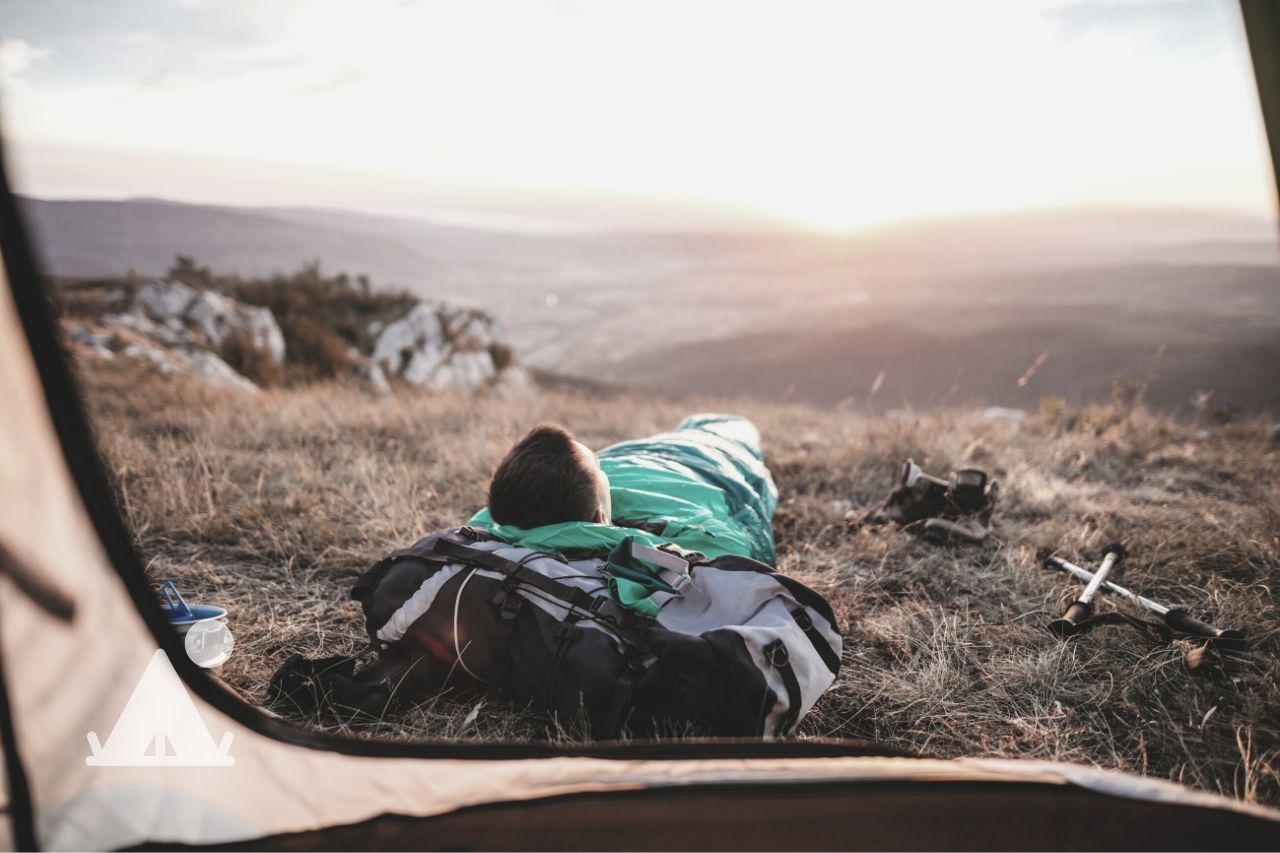Finding the right sleeping bag involves much more than checking and comparing price lists. Your choice will depend on several factors such as weight, weather conditions, packability, insulation choices, warmth and more. I’ll walk you through all of these angles to help you find the best sleeping bag for the money.
Think About the Bag Insulation

Choosing the right material for your sleeping bag insulation is an essential part of the whole comfort and warmth factor. There are mainly two types of insulation materials; down and synthetic insulation.
While both are equally good, of course, there will be one that may be more suitable for you than the other, depending on your adventure activities, travel style, and budget.
Let’s look at the pros and cons of each insulation option in more detail.
Down Insulation
Let’s be clear about this one thing: down fill does not come from goose or duck feathers, but rather, from a cluster of soft, fluffy stuff that lay beneath the feathers.
Down fill is unarguably nature’s best insulator. It’s impressive how it provides warmth in a very light package. What else makes down sleeping bags great is their compressibility and resilience. These bags compress easily without losing their shape or loft over time. If cared for properly, it can serve you for years.
The downside to using a down bag is when exposed to moisture, it loses its insulation properties. To cope with the moisture crisis, these bags are filled with water repellent down. However, this only deals with light contact with rain. So if you get caught in heavy rain, the treated down won’t do you any good.
It also takes a long time to dry, so try as much as you can to keep the bag dry. Down filled bags are also more expensive than synthetics. If a bag uses pure goose down or has a high fill power, the price can go even higher.
Before you get all confused, a fill power basically indicates the quality of a down. Higher fill power means greater warmth for the same weight of down.
Side note: it’s always a good idea to get sleeping bags that are certified by Responsible Down Standard (RDS) or Traceable Down Standard (TDS) especially if you are concerned about animal welfare. Certified companies acknowledge the rights of animals and treat the geese and ducks humanely and with respect.
Synthetic Insulation
Most synthetic bags are made from polyester. While these bags may not be as compressible as down, they still retain heat even when wet. So if you are planning to camp in rainy or wet conditions, your chances of a comfortable warmer night are a bit higher with a synthetic than a treated down bag.
Moreover, synthetics are easier to care for, dry much quicker, suitable for highly sensitive people and come with a cheaper price tag. On the downside, the bags are less durable, heavier and bulkier than down equivalents.
Some manufacturers combine synthetic and down insulation to give you the best of both worlds. Of course, the bags are going to be heavier and bulkier than pure down and more expensive than pure synthetic.
So which option should you go for? Both excel in different areas. So it all comes down to the option that aligns with your needs. Car camping or backpacking? Camping in a damp or dry climate? Regular or casual camper? How much money are you willing to spend on a sleeping bag? These questions will help point you in the right direction.
Consider the Shapes and Sizes

The shape of a sleeping bag is an important but often overlooked aspect by some. It can affect how warm and comfortable you sleep at night, how heavy the bag is and how much space it takes up inside your pack.
Sleeping bags come in different shapes and sizes. The main ones include:
Mummy
This snug-fitting sleeping bag is the most popular among backpackers and mountaineering enthusiasts. Its snug fit traps your body heat inside the bag, keeping you all toasty.
The slim cut means less material hence less weight and small pack size. Now you see why backpackers fancy this option. The catch? The body-hugging might not go well with claustrophobics or restless sleepers.
Rectangular
These bags have enough room to stretch and turn comfortably unlike mummy bags. But this also means a lot of body heat will escape. If your plans include camping in a cold location, this might not be a great option.
While rectangular sleeping bags are heavier and bulkier than other shapes, they are the most versatile. Most of them can open up fully to be used as blankets or picnic rugs.
If comfort is the top line of your priority list or planning a summertime camping adventure, this is an ideal choice.
Semi-rectangular/Barrel
A barrel-shaped bag strikes a good balance between roominess and warmth. The bag keeps you warm while still feeling reasonably comfortable. It’s not as warm and light as a mummy bag or spacious and heavy as a rectangular bag, but it’s a good compromise.
When it comes to sleeping bag sizes, there’s no one size fits all. Women bags, for example, are slightly shorter than men’s and unisex bags. The bags are also a bit wider at the hips and narrower at the shoulders. But this does not mean only women can use these sleeping bags. Skinny and short dudes might find these bags more comfortable than men’s bags.
Side note: The length of the sleeping bag should match your height. A bag that’s too short or too long might not perform as efficiently as it should, and you may end up being cold.
Let’s Talk Temperature Rating
A sleeping bag temperature rating is not as straightforward as you might expect. It can get a little complicated, but I’ll break it down for you.
Temperature rating is an indication of how warm a sleeping bag is. It gives you the absolute minimum temperature at which the bag is designed to keep the average person warm.
However, there is no industry standardization of temperature ratings on the US market. So this means the ratings may vary from one manufacturer to the next.
But here’s where people often get confused;
A sleeping bag rating is not the only factor that determines the comfort and warmth of a bag. There is a wide range of variables that also come into play.
Let me give a scenario of the warmth factor. You see, we all have different body types and sleep differently. What feels warm to you may feel different from the other person. Also, women sleep colder than men. That’s why a woman or cold sleeper would need a warmer bag than a hot sleeper.
What’s just as important is your sleeping bag fit. A proper fitting bag will keep you warmer than a roomier bag.
The warmth of your sleeping pad, your age & gender, the type of clothing you wear at night, the type of tent you’re camping with and the number of people you’re sharing it with can have a significant impact on how warm you sleep.
This clearly shows why you should not rely too much on a bag’s temperature rating. You should only use it as a guide.
Let’s dive a little further into the categorization of these ratings.
Sleeping bags ratings are often grouped into:
- Summer: +35°F and above
- 3-season: +10°F – +35°F
- Winter: -10°F – +10°F
- Expedition: -10°F and below
Side note: 3 seasons sleeping bags are the most versatile as they are best suited for spring, fall and even summer trips. Not so many families or individuals would need expedition bags. But diehards who venture into extreme conditions would tell you how important these bags are.
To find a proper estimate rating, find out the lowest temperature you can expect to experience and then add about 10 to 15 degrees. Getting too warm is always better than shivering in your tent. Besides, you can still open your bag if it gets uncomfortably hot.
What do EN or ISO rated sleeping bags mean?
You’ve probably seen bags that have the EN or ISO rating and wondered what they are and what they mean. The EN rating was developed in Europe and stands for European Norm. It’s a standardized rating for sleeping bags. ISO is an updated version to the EN rating; however, there isn’t much difference between the two tests.
Here are the meanings of EN temperature ratings:
- Comfort: the lowest temperature at which the bag would keep a ‘standard’ woman comfortable.
- Limit: the lowest temperature in which a ‘standard’ man could be comfortable in the sleeping bag.
- Extreme: the extreme lowest temperature you can survive in the sleeping bag without freezing to death. This range is only used in the worst case scenarios.
Although the EN rating recognizes the difference between men and women temperatures, they are still based on assumptions. The ratings are not meant to provide a specific rating, but to steer you in the direction when shopping for a bag. Like I explained above, lots of factors affect how warm we sleep.
In conclusion, these temperature ratings do not guarantee the warmth of any sleeping bag. They only act as basic guidelines to make it easier for you to choose a bag.
To find the best sleeping bag for the money, use the temperature ratings plus the other variables (sleepwear, sleeping pad warmth, gender, etc.).
What About the Extras?
Some features can fine-tune the level of comfort in your sleeping bag.
- Hood – A hooded sleeping bag provides that extra warmth around your head and ears.
- Collar – It comes in handy when camping in winter or cold weather. Its wrapped around the neck to prevent warmth inside your bag from escaping. A draft tube serves the same purpose but runs the full length of the main zipper.
- Zippers – Anti-snag double zippers not only provide smooth opening and closing but more venting options as well.
- Pockets – Some bags have pockets to stash your small items. Others come with a pillow pocket to stuff your pillow or extra clothes.
- Compression sack – Minimizes your sleeping bag volume to take less space in your backpack.
In the end, knowing what to look for makes all the difference. It makes it so much easier to find the perfect sleeping bag that suits your needs. I hope this guide has proven helpful. Cheers!